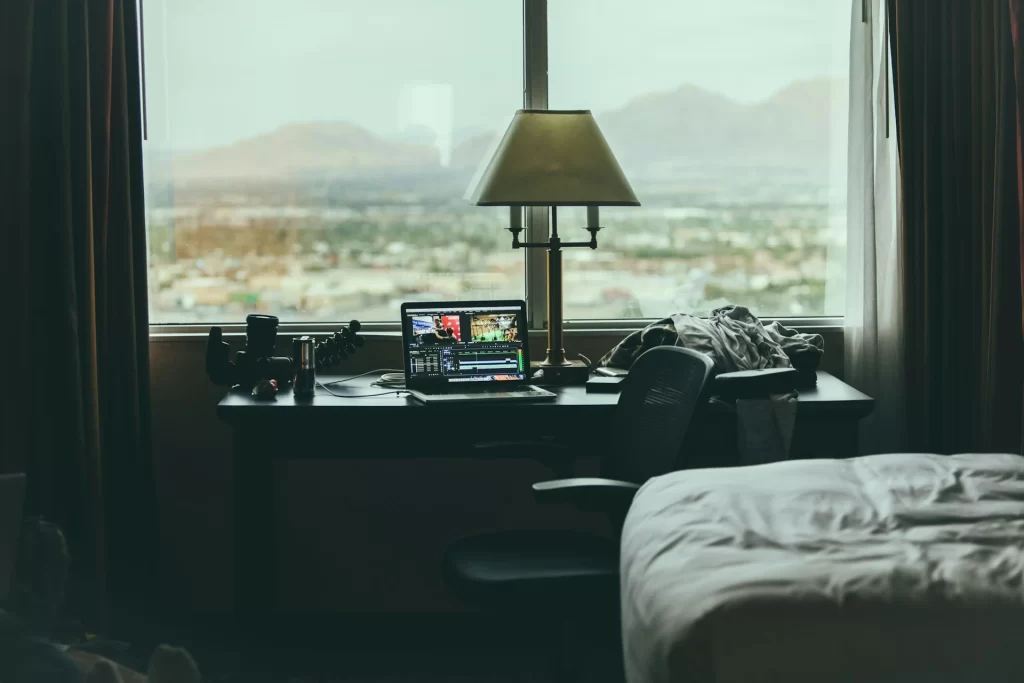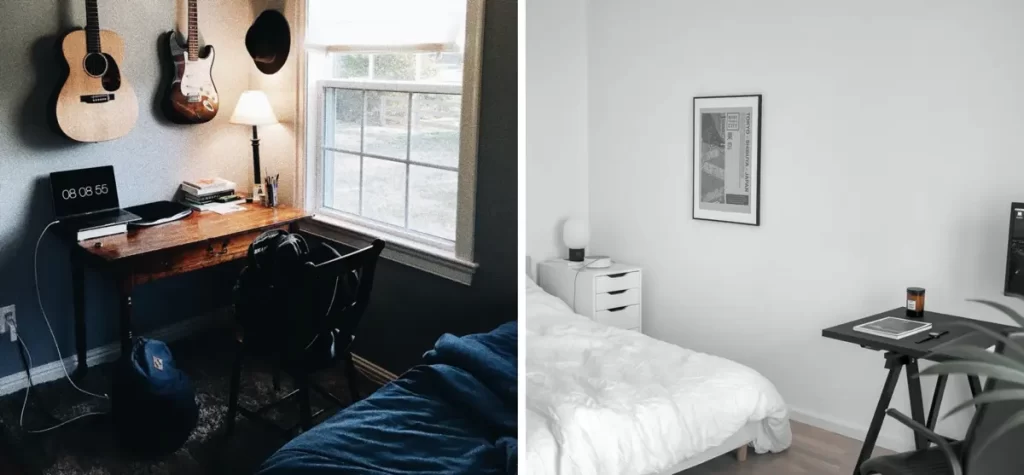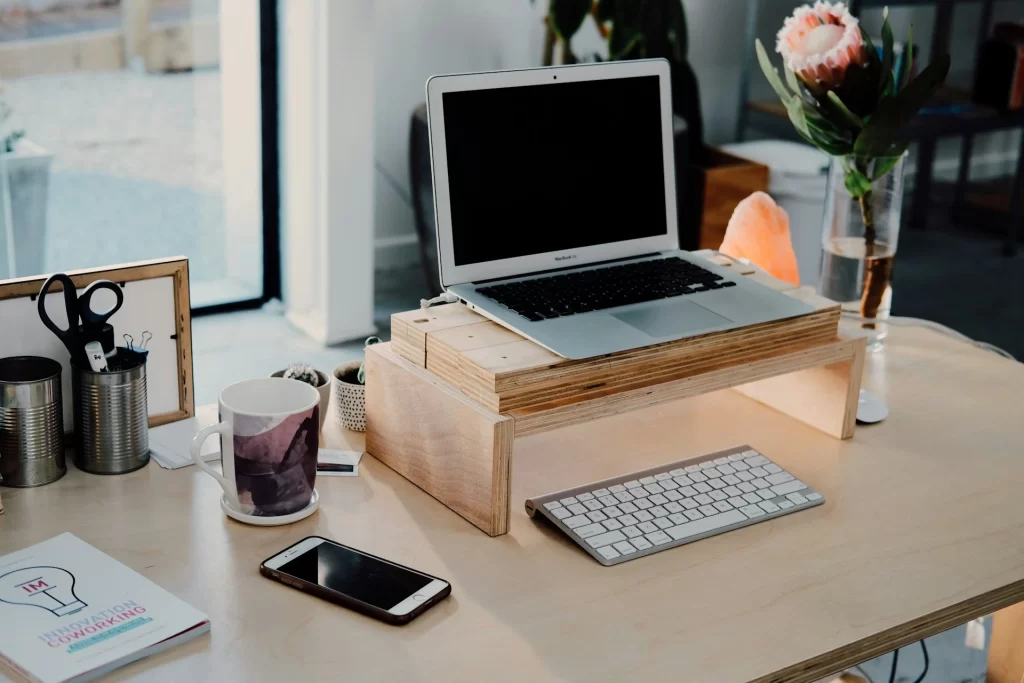
In this blog, while we often delve into strategies for working while traveling, the reality is that for most of us, the bulk of our work year is spent in our home or bedroom offices. While perhaps less glamorous, the topic of working from our (often small) apartments is essential.
When traveling, you have options for accommodations that can impact your workspace. You might choose a larger hotel room or an Airbnb with multiple rooms to serve as separate offices. However, working from home offers less flexibility in this regard. Your bedroom, as a fixed space, comes with inherent constraints that aren’t easily overcome without relocating or upgrading.
Most people simply work in their bedrooms without thinking enough about the physical layout, tools, and habits they need. A sloppy bedroom office setup hurts. Typical bedroom offices have limited space, subpar lighting, electronic distractions, potential clutter from clothing, and likely cause some disturbance to sleep quality.
With thoughtful planning, it’s possible to make a small bedroom workspace function effectively. Prepare your office-bedroom combo for success, starting with a few key principles.
Principles and Preparation for an Office-Bedroom Combo
To maximize the odds of a successful office-bedroom combo, you should follow these principles:
- Ensure your bedroom is designed in a way that values function over form
- Ensure that every area of your bedroom or furniture is single-use as far as possible.
First, function over form. To balance both productivity and restfulness in one space, you may have to sacrifice form and aesthetics to an extent.
Functionally, there will be two contrasting vibes and setups — thus here are two examples of compromises you could make:
- You should have different lights for productivity and rest: Include both cool lighting (for office and productivity) and warm lighting (for bedroom and sleep).
- Even though they give off homey and inviting vibes suiting a bedroom, squishy armchairs or couches might have to give way to a work desk and ergonomic chair.
The second principle is to keep different furniture and areas in your bedroom single-use as far as possible.
Here are ways to keep your work and rest areas organized and separated within a bedroom office:
- Avoid working on the bed. This trains your brain to not associate your bed with productivity. You do not carry over any stresses and unhappiness of your workday onto your bed.
- Ensure that your bedroom has good ventilation. That means good airflow with open doors, windows, fans, or air-conditioning. Else, you may get easily frustrated and lose your focus in a stuffy, warm, and cramped room.
- Work at your main desk. This is the productive zone where you do your best work. Be productive at your desk, not on your bed.
- Add a desk lamp if necessary. Add a lamp to provide a cool daylight color temperature at your desk (a color for productivity), while the rest of your bedroom has a warmer tone for sleep at night.
- Have different zones in your bedroom. Distinguish between your bed, desk, storage cabinets, and areas of recreation, creativity, or meditation.
- Set up a creative zone. This might be a corner desk or shelves that you fill with plants, books, and other decorative objects to stimulate your brain juices and enable inspiration finding.
- Set up a wall organizer to organize your tools. By maximizing unused wall space for storage, you keep the rest of your bedroom organized. You can use a pegboard to store daily gadgets and accessories, such as chargers, power banks, USB cables, and headphones.
- Space your furniture out. Make sure there is enough space for circulation. You want to have ample space to easily walk around your bed, closet, and desk.
- Keep digital tools and paperwork from lying around. Clutter leads to distraction, which can lead you down the path of lazing around when it is working hours.
Given the principle of single-use, I’d always recommend a spare room first and foremost for your office. But if you do not have one available, do weigh the pros and cons of setting up a (mini) workspace in other areas of your apartment, before deciding on your bedroom as your primary workspace.
- Besides the bedroom, you could consider the living room and compare the differences in space, function, lighting, distractions, and privacy.
- Furthermore, you should ask yourself these questions before setting up a bedroom office – seriously consider the disadvantages.
If you’ve decided that it’s best to have an office in your bedroom, read on.
10 Tips to Set Up Your Office-Bedroom Combo
You are ready to invest some effort into a productive bedroom office setup.
Here are 10 tips for a success office-bedroom combo.
1. Locate your desk tactically in your bedroom
First, it is important to keep your bed out of sight when you work.
When you sit on your desk, you want to avoid seeing your bed, with a simple turn of the head to the left or right. Seeing your bed can kill your productivity. In contrast to your desk, your bed is the most tempting and distracting thing in your bedroom. The more head turns you make, the more it lures and invites you into its company.

What some people do is have their beds appropriately placed on the opposite side of the room from the desk.
Facing the wall, turning your head 180 degrees – to see the bed behind you – is physically impossible, unless you turn your body as well.
This is a good thing and reduces your temptation to sprawl on your bed.
Second, locate your desk near a window if you have one. A challenge of working in the bedroom is the difficulty of receiving natural light. Studies have proven that sunlight makes us more productive, as the natural light we get during the day reduces stress and improves concentration. If you could not locate your desk near a window, install task lights to ensure that your area is well-lit.
2. Set up arbitrary zones to separate ‘bedroom’ from ‘office’
This piece of advice should not be underestimated: Avoid working in the exact same places that you sleep.
The brain learns quickly to associate a certain space with certain things. By working in your bedroom, your brain starts associating your bedroom with productivity, unfinished projects, stress, and unhappiness. This can carry on after work, simply because you work and rest in the exact same room.
At the minimum, you would want to avoid working on the bed. The next best thing you can do is to set up dedicated zones for different activities. This helps you to enforce spatial boundaries.
Here are some examples of ways to separate your ‘bedroom’ and ‘office’:
- Set up a main desk with work electronics and ergonomic chair. Have all your work essentials and gadgets organized in a central place
- Have a creative zone. This can be a space with a small couch or massage chair to dream and connect ideas
- Create a meditation corner. This can be a desk or seat that is conducive to quieting your mind. Make it cozy with cushions, candles, dim lights and incense sticks.
- Set up your bed. Make it super comfortable
Be productive at your desk, and relaxed elsewhere – on your couch, bed, or at your recreational corner when you are not working.
This article was originally published on unboundist.com. If it is now published on any other site, it was done without permission from the copyright owner.
3. Use small and portable tools for your workspace
If you need to switch between desks or corners, do that to stay productive. For example, here are some tools you could use:
- Folding table: It is clever to use a folding table, which makes your workspace “portable” since the table is easy to fold, keep, and set up anywhere.
- Lap desk: It is designed for you to work comfortably from any spot in your home, with your laptop on your lap.
- Recliner: Use a recliner with leg rest and lumbar support, which is best for reading and relaxing during breaks in front of good scenery.
These tools add flexibility in a small bedroom. You can experiment working in different parts of your bedroom, or even your home. Simply switch between different spots during the day.
Related: 10 Alternative Ways to Productively Work Without a Desk
4. Create a distraction-free desk space
For a bedroom-office combo, organization is absolutely crucial. If you have visible clutter such as piles of dirty clothes, papers, and work documents lying around, take care of them immediately.
Make your desk look minimalist – your desk surface should only contain the everyday items that you use frequently. The essentials are your laptop/monitor, keyboard, and mouse.
More items on your desk create extra visual stimuli, clutter, and distraction. Less is better.
Here are more ideas on creating a distraction free workspace
- A good practice is to utilize under-desk storage or drawers and filing cabinets; store the things you do not need daily out of sight.
- Cables can also create clutter in our workspace that affects our mood and productivity. Manage cables using tools such as velcro ties, a desk-mounted cable management box, or an under-the-desk cable storage tray. A simple Google search gives you plenty of options.
- Further, here’s a list of ideas to make your bedroom desk and mini workspaces look as minimalist and clean as possible.
5. Set the right temperature
If you have air conditioning, the advantage of working in your bedroom is that you get to control your room’s temperature.
Generally, you want your room to be cool enough so that you can concentrate on cognitive tasks, but not too cold.
Researchers found that when temperature was raised from 68 to 77 degrees Fahrenheit (20 to 25 degree Celsius), office workers’ typing errors decreased by 44%, while their typing output increased by 150%. However, going beyond 77 degree Fahrenheit may be too warm, and hotter environments tend to create more lethargy and less focus.
Experiment with temperatures to find your personal best working temperature.
6. Choose the right colors
Researchers have found that colors directly impact productivity. Colors impact the way which we perform in professional contexts. Believe it or not, different shades of colors are capable of boosting productivity in different ways, depending on personality, team dynamics, and the type of business an entrepreneur has.
While an all-white minimalist bedroom sounds nice to have, it is better to create zones of color that are conducive for different activities – rest, creativity, and performance. After all, a bedroom office is multifunctional.
Here’s a brief list of what different colors stimulate according to researchers:
- Cognitive processes: Yellow, Olive green
- Creativity: Blue, splashes of red, violet
- Rest and Wellbeing: Green, pink, coral
- Awareness and spiritual reflection: Violet
Interestingly, the colors yellow, blue, and green not only promote sleep, but help us work more productively – unlike red, purple, and brown. Thus, we can safely include these colors in our bedroom office:
- Yellow supports our ability to make decisions, concentrate, and engage our cognitive processes.
- Blue supports creativity, and it can help with facilitating conversation and communication with others.
- Green adds a calming atmosphere, as well as ‘life’ and vibrancy to a built-up urban office environment.
Related: Best Light Colors for Productive Work (Learning, Creativity, and Concentration)
To add colors, you might not choose to re-paint your walls or buy sleek furniture. Perhaps that is too much work for you. Fortunately, you can use lighting as a color ‘hack’, which we’ll now discuss.
7. Choose the right lighting
Lighting is an essential element of your office-bedroom combo. One hack to light up the multifunctional space is to make use of smart light bulbs, which can set contrasting moods for work and non-work. Likely, you have already seen this in ‘smart home’ videos and the productivity setup of various YouTubers.

Here’s what to know about smart lighting at a glance:
- Smart bulbs can be controlled to deliver lighting of varying colors and intensities.
- These bulbs can be controlled using Bluetooth connections, remote controls, and apps such as Amazon’s Alexa.
- By changing the colors of our lights, we stimulate our bodies and minds differently.
But if using different colors is too much for you, simply stick with the basics – make sure to use warm and cool lighting.
Warm lighting helps you relax and sleep. Cool lighting helps you concentrate and be productive. Cool lighting is probably a fixture you need to add to your existing bedroom, in order to make it a bedroom office.
If you are interested to learn more about the contrast that your lighting can create for you at different times of the day, read this article for 11 bedroom lighting tips to help you create a multifunctional space where you do very different things, under very different moods, maximizing productivity and relaxation at different times.
8. Invest in ergonomic tools
The chances are that your bedroom is a relatively small and unergonomic space by default, not designed for long periods of productive work. This means you could easily develop and fall into bad habits if you do not make shrewd improvements to your bedroom.
Investing in ergonomic tools does NOT necessarily mean you have to spend a ton of money.
Invest wisely – the principle is to invest on things that give you good ROI (return on investment) for years in the places where you spend your energy. Some examples of ergonomic tools you could invest in are:
- Laptop stands
- An ergonomic chair (such as a recliner)
- An ergonomic keyboard or keyboard tray for natural placement of hands and wrist movement
- A standing desk
There are laptop stands that cost less than $50 that you can use for years. They can alleviate strain and improve your neck and shoulder posture by raising your laptop to an eye level. Alternatively, you can use multiple drawers or books to prop up your laptop to a desired height.

You can also work standing. A sit-stand desk is ideal. However, if a standing desk is outside your budget, consider these alternatives – they are cheaper but enable a small functional standing desk space.
Besides your desk itself, your chair is arguably the next most important item. We spend hours upon hours sitting. Yet, not everyone would bother to invest in a comfortable chair.
- An ergonomic chair usually contains lumbar support following the natural curve of your lower back. You should adjust the height to place your feet flat on the ground, allowing increased blood flow and circulation.
- Consider using a recliner chair to work comfortably, pause during breaks, and take power naps. Most recliner office chairs have a footrest that provides support so that your feet do not hang uncomfortably in the air, especially if you have a smaller frame.
9. Maximize Storage Space
Setting up a multi-functional bedroom office is challenging, because a bedroom has limited space.
Maximizing storage is a solution to this problem. There are two ways: Store items on your walls, or keep them hidden away in drawers and boxes.
One way to save floor space in a small bedroom is to use a wall organizer. For example, organize your everyday items and devices using a pegboard. Use a pegboard to organize your gadgets and office accessories.
Storing your items away sounds like a boring chore, but it can give your eyes and brain the much needed break:
- Some things are meant to be hidden. These are your less used items that you do not need to display or access daily.
- Before you hide them, be minimalist and get rid of the items you do not need.
- Then, implement some storage ‘hacks’, such as using under-desk shelving, drawers, or tucking away less-used items in storage boxes underneath your bed.
10. Transform Your Bedroom Office Once the Day Ends
If you are someone with poor work-life balance, it can be really helpful to make a few adjustments to your bedroom office once the day ends.
- Use candles to set a different mood that enables relaxation
- Use thicker curtains to block out lights in the evenings. To keep your desk out of sight, you can ‘close the curtains’ at the end of the workday.
- Change the color lighting of your room
- Shut down your computer so you wouldn’t engage with your monitor screen.
All in all, it helps to ‘disappear’ your workspace as you do not want to be staring at your unfinished projects during recreational evenings and bedtime. This can help you get a good night’s sleep.
Summary
Now that you have quite a comprehensive list of ideas, have fun setting up your bedroom office.
The next step is thriving in your bedroom office. Being productive in your bedroom is only possible with the right habits and strategies – here is a list of ideas to save you from wasted time and restless days.